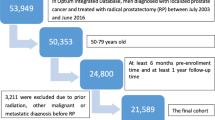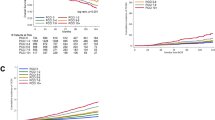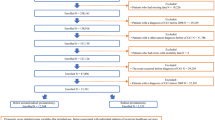Abstract
Background:
With the increasing use of robotic surgery in the United States, the comparative effectiveness and differences in reimbursement of minimally invasive radical prostatectomy (MIRP) and open prostatectomy (ORP) in privately insured patients are unknown. Therefore, we sought to assess the differences in perioperative outcomes and hospital reimbursement in a privately insured patient population who were surgically treated for prostate cancer.
Methods:
Using a large private insurance database, we identified 17 610 prostate cancer patients who underwent either MIRP or ORP from 2003 to 2010. The primary outcomes were length of stay (LOS), perioperative complications, 90-day readmissions rates and hospital reimbursement. Multivariable regression analyses were used to evaluate for differences in primary outcomes across surgical approaches.
Results:
Overall, 8981 (51.0%) and 8629 (49.0%) surgically treated prostate cancer patients underwent MIRP and ORP, respectively. The proportion of patients undergoing MIRP markedly rose from 11.9% in 2003 to 72.5% in 2010 (P<0.001 for trend). Relative to ORP, MIRP was associated with a shorter median LOS (1.0 day vs 3.0 days; P<0.001) and lower adjusted odds ratio of perioperative complications (OR: 0.82; P<0.001). However, the 90-day readmission rates of MIRP and ORP were similar (OR: 0.99; P=0.76). MIRP provided higher adjusted mean hospital reimbursement compared with ORP (US$19 292 vs US$17 347; P<0.001).
Conclusions:
Among privately insured patients diagnosed with prostate cancer, robotic surgery rapidly disseminated with over 70% of patients undergoing MIRP by 2009–2010. Although MIRP was associated with shorter LOS and modestly better perioperative outcomes, hospitals received higher reimbursement for MIRP compared with ORP.
This is a preview of subscription content, access via your institution
Access options
Subscribe to this journal
Receive 4 print issues and online access
$259.00 per year
only $64.75 per issue
Buy this article
- Purchase on Springer Link
- Instant access to full article PDF
Prices may be subject to local taxes which are calculated during checkout

Similar content being viewed by others
References
Siegel R, Naishadham D, Jemal A . Cancer statistics, 2012. CA Cancer J Clin 2012; 62: 10–29.
Anderson JE, Chang DC, Parsons JK, Talamini MA . The first national examination of outcomes and trends in robotic surgery in the United States. J Am Coll Surg 2012; 215: 107–114.
Wright JD, Ananth CV, Lewin SN, Burke WM, Lu YS, Neugut AI et al. Robotically assisted vs laparoscopic hysterectomy among women with benign gynecologic disease. JAMA 2013; 309: 689–698.
Hu JC, Gu X, Lipsitz SR, Barry MJ, D'Amico AV, Weinberg AC et al. Comparative effectiveness of minimally invasive vs open radical prostatectomy. JAMA 2009; 302: 1557–1564.
Nguyen PL, Gu X, Lipsitz SR, Choueiri TK, Choi WW, Lei Y et al. Cost implications of the rapid adoption of newer technologies for treating prostate cancer. J Clin Oncol 2011; 29: 1517–1524.
Wilt TJ, MacDonald R, Rutks I, Shamliyan TA, Taylor BC, Kane RL . Systematic review: comparative effectiveness and harms of treatments for clinically localized prostate cancer. Ann Intern Med 2008; 148: 435–448.
Kowalczyk KJ, Levy JM, Caplan CF, Lipsitz SR, Yu HY, Gu X et al. Temporal National Trends of Minimally Invasive and Retropubic Radical Prostatectomy Outcomes from 2003 to 2007: Results from the 100% Medicare Sample. Eur IUrol 2011; 61: 803–809.
Hu JC, Wang Q, Pashos CL, Lipsitz SR, Keating NL . Utilization and outcomes of minimally invasive radical prostatectomy. J Clin Oncol 2008; 26: 2278–2284.
Ficarra V, Cavalleri S, Novara G, Aragona M, Artibani W . Evidence from robot-assisted laparoscopic radical prostatectomy: a systematic review. Eur Urol 2007; 51: 45–55; discussion 56.
Ficarra V, Novara G, Artibani W, Cestari A, Galfano A, Graefen M et al. Retropubic, laparoscopic, and robot-assisted radical prostatectomy: a systematic review and cumulative analysis of comparative studies. Eur Urol 2009; 55: 1037–1063.
Jacobs BL, Zhang Y, Schroeck FR, Skolarus TA, Wei JT, Montie JE et al. Use of advanced treatment technologies among men at low risk of dying from prostate cancer. JAMA 2013; 309: 2587–2595.
Mirkin JN, Lowrance WT, Feifer AH, Mulhall JP, Eastham JE, Elkin EB . Direct-to-consumer Internet promotion of robotic prostatectomy exhibits varying quality of information. Health Aff (Millwood) 2012; 31: 760–769.
Kim SP, Shah ND, Karnes RJ, Weight CJ, Shippee ND, Han LC et al. Hospitalization costs for radical prostatectomy attributable to robotic surgery. Eur Urol 2012; 64: 11–16.
Trinh QD, Sammon J, Sun M, Ravi P, Ghani KR, Bianchi M et al. Perioperative outcomes of robot-assisted radical prostatectomy compared with open radical prostatectomy: results from the Nationwide Inpatient Sample. Eur Urol 2012; 61: 679–685.
Makarov DV, Yu JB, Desai RA, Penson DF, Gross CP . The association between diffusion of the surgical robot and radical prostatectomy rates. Med Care 2011; 49: 333–339.
Neuner JM, See WA, Pezzin LE, Tarima S, Nattinger AB . The association of robotic surgical technology and hospital prostatectomy volumes: increasing market share through the adoption of technology. Cancer 2012; 118: 371–377.
Gandaglia G, Sammon JD, Chang SL, Choueiri TK, Hu JC, Karakiewicz PI et al. Comparative effectiveness of robot-assisted and open radical prostatectomy in the postdissemination era. J Clin Oncol 2014; 32: 1419–1426.
Gandaglia G, Abdollah F, Hu J, Kim S, Briganti A, Sammon JD et al. Is robot-assisted radical prostatectomy safe in men with high-risk prostate cancer? Assessment of perioperative outcomes, positive surgical margins, and use of additional cancer treatments. J Endourol/Endourol Soc 2014; 28: 784–791.
IMS Institute for Healthcare Informatics. Available at: http://www.imshealth.com/portal/site/imshealth/menuitem.d583644423e6edf2f786f7861ad8c22a/?vgnextoid=598de5fda6370410VgnVCM10000076192ca2RCRD&vgnextfmt=default. (last accessed 1 January 2014).
Elixhauser A, Steiner C, Harris DR, Coffey RM . Comorbidity measures for use with administrative data. Med Care 1998; 36: 8–27.
Consumer price indexes for major expenditure classes 1965–2009. Available at: http://www.gpo.gov/fdsys/pkg/ERP-2010/pdf/ERP-2010-table60.pdf. (last accessed 1 December 2012).
Manning WG, Willard G, Mullahy J . Estimating log models: to transform or not transform? J Health Econ 2001; 20: 461–494.
Effron B . Bootstrap methods: another look at the jackknife. Biometrics 1979; 7: 1–26.
Mariotto AB, Yabroff KR, Shao Y, Feuer EJ, Brown ML . Projections of the cost of cancer care in the United States: 2010–2020. J Natl Cancer Inst 2011; 103: 117–128.
Bolenz C, Freedland SJ, Hollenbeck BK, Lotan Y, Lowrance WT, Nelson JB et al. Costs of radical prostatectomy for prostate cancer: a systematic review. Eur Urol 2012; 65: 316–324.
Trinh QD, Sammon J, Sun M, Ravi P, Ghani KR, Bianchi M et al. Perioperative outcomes of robot-assisted radical prostatectomy compared with open radical prostatectomy: results from the nationwide inpatient sample. Eur Urol 2012; 61: 679–685.
Begg CB, Riedel ER, Bach PB, Kattan MW, Schrag D, Warren JL et al. Variations in morbidity after radical prostatectomy. N Engl J Med 2002; 346: 1138–1144.
Hu JC, Gold KF, Pashos CL, Mehta SS, Litwin MS . Role of surgeon volume in radical prostatectomy outcomes. J Clin Oncol 2003; 21: 401–405.
Lotan Y, Bolenz C, Gupta A, Hotze T, Ho R, Cadeddu JA et al. The effect of the approach to radical prostatectomy on the profitability of hospitals and surgeons. BJU Int 2010; 105: 1531–1535.
Barbash GI, Glied SA . New technology and health care costs—the case of robot-assisted surgery. N Engl J Med 2010; 363: 701–704.
Kim SP, Boorjian SA, Shah ND, Weight CJ, Tilburt JC, Han LC et al. Disparities in access to hospitals with robotic surgery for patients with prostate cancer undergoing radical prostatectomy. J Urol 2013; 189: 514–520.
Welch HG, Albertsen PC . Prostate cancer diagnosis and treatment after the introduction of prostate-specific antigen screening: 1986–2005. J Natl Cancer Inst 2009; 101: 1325–1329.
Author information
Authors and Affiliations
Corresponding author
Ethics declarations
Competing interests
SPK was supported by a career development award from the Conquer Cancer Foundation of the American Society of Clinical Oncology. The remaining authors declare no conflict of interest.
Rights and permissions
About this article
Cite this article
Kim, S., Gross, C., Smaldone, M. et al. Perioperative outcomes and hospital reimbursement by type of radical prostatectomy: results from a privately insured patient population. Prostate Cancer Prostatic Dis 18, 13–17 (2015). https://doi.org/10.1038/pcan.2014.38
Received:
Revised:
Accepted:
Published:
Issue Date:
DOI: https://doi.org/10.1038/pcan.2014.38



